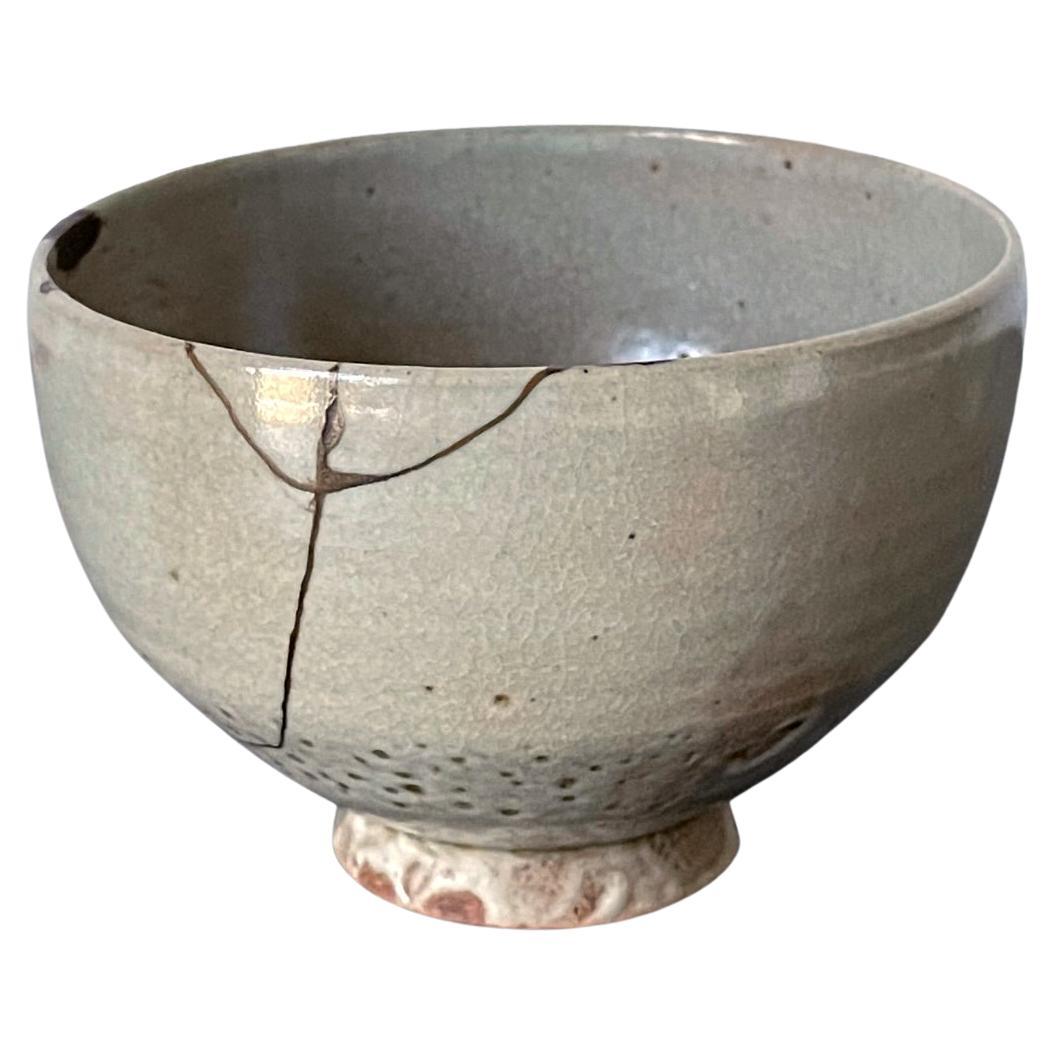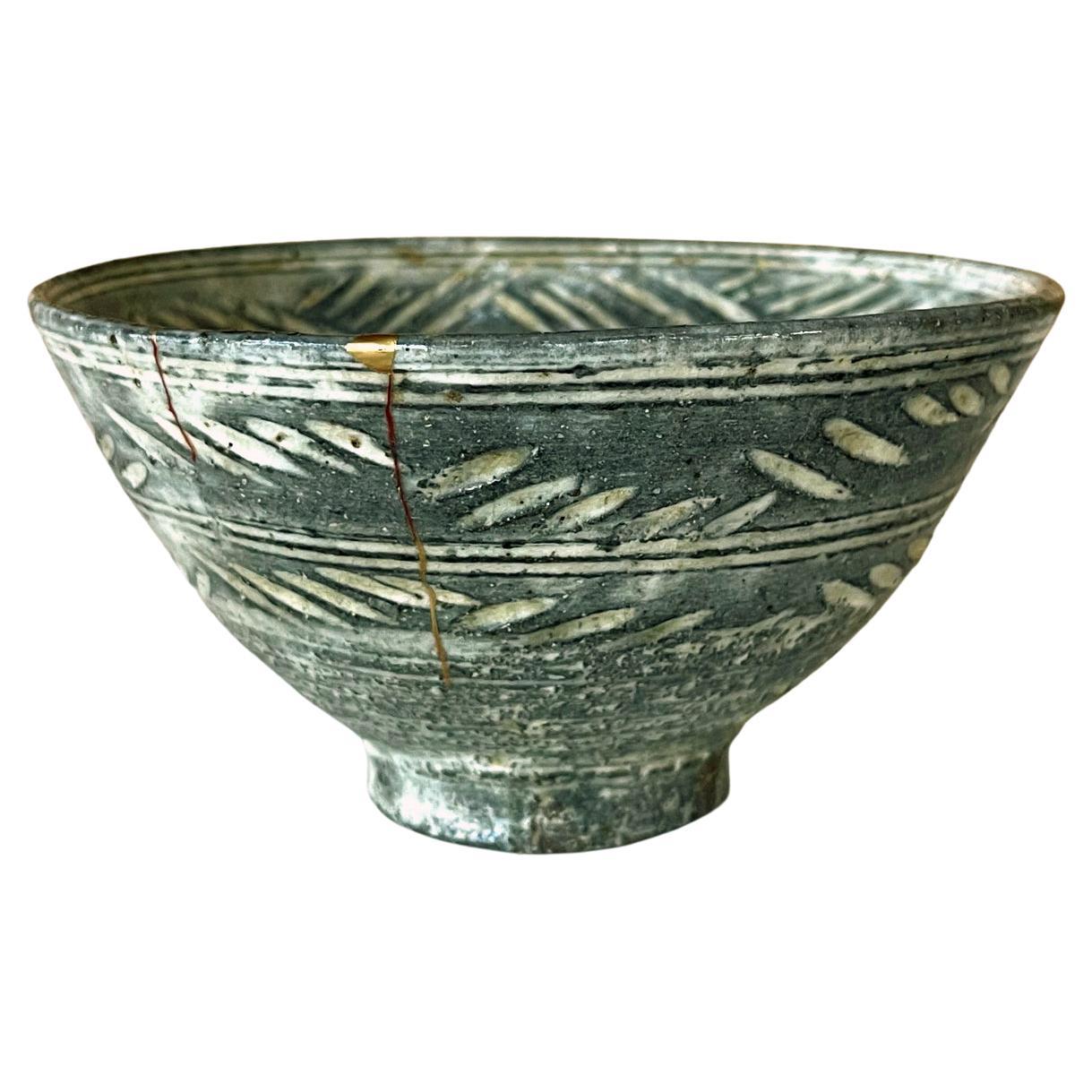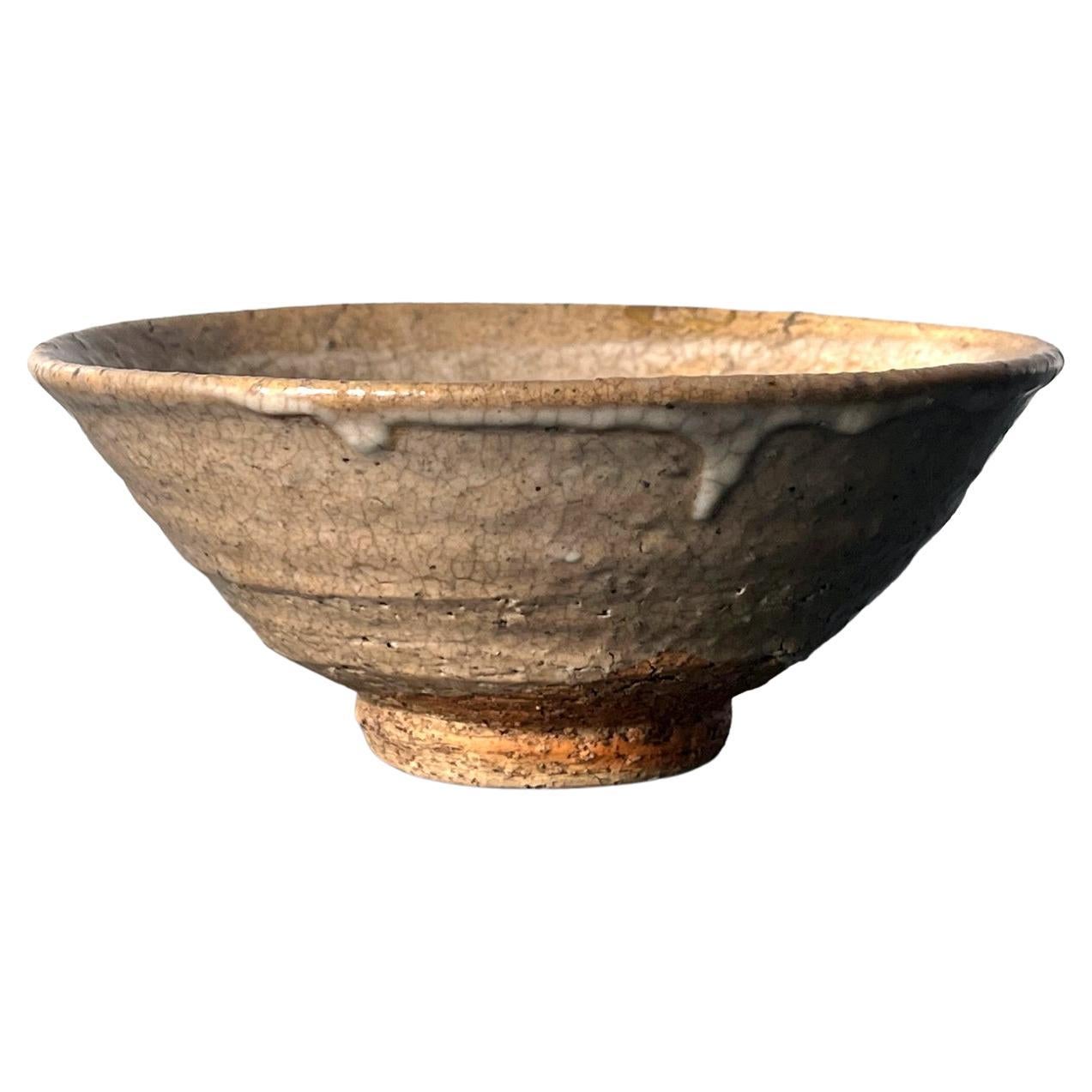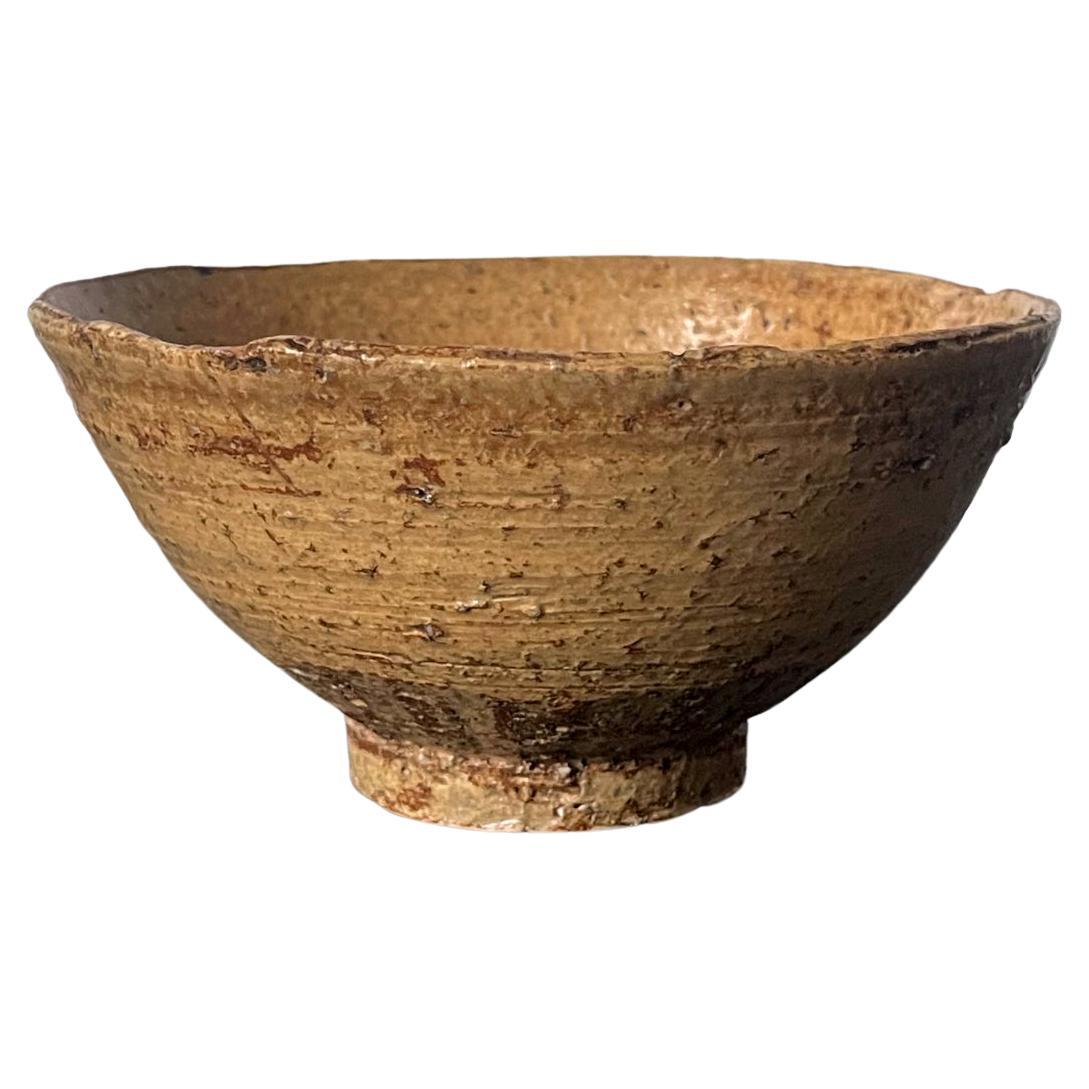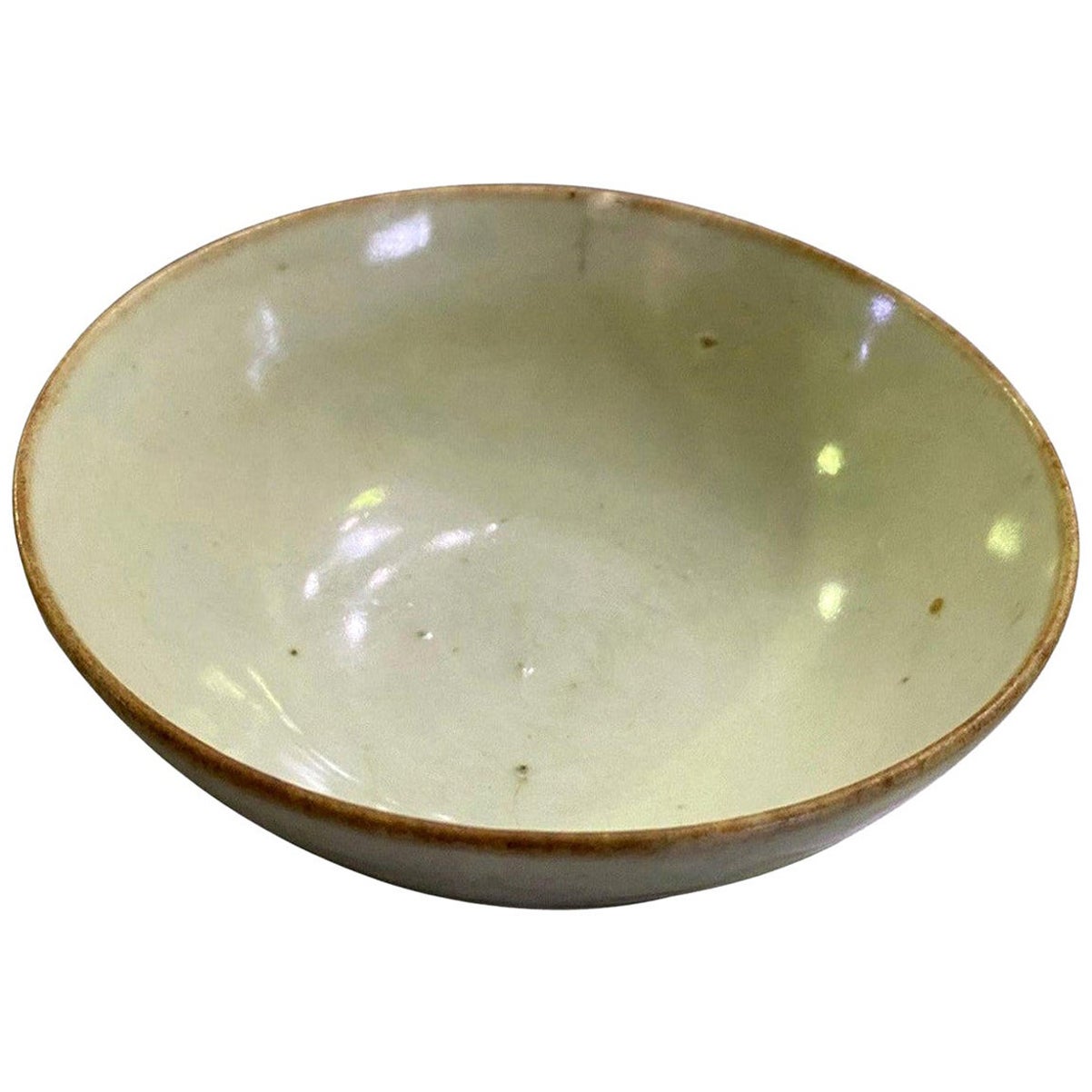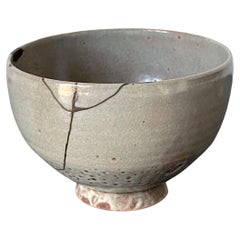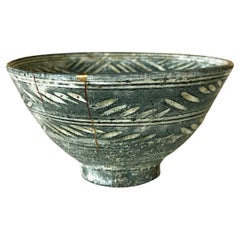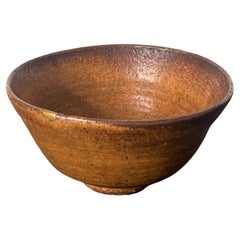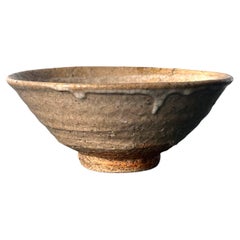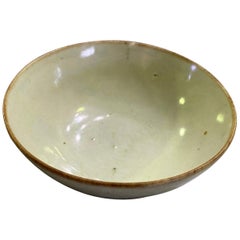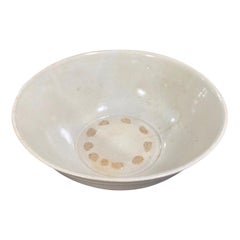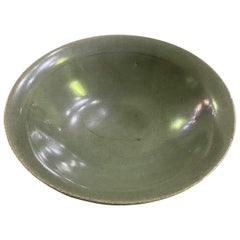Items Similar to Korean Gohon Chawan Tea Bowl for Japanese Market Joseon Dynasty
Want more images or videos?
Request additional images or videos from the seller
1 of 17
Korean Gohon Chawan Tea Bowl for Japanese Market Joseon Dynasty
About the Item
A ceramic chawan (tea bowl) circa 17-18th century fired in the Busan kiln in Korean specifically for the Japanese market. The kilns were run by the So clan that ruled Tsushima Island to fill the order from Japan with detailed preference. Gohon therefore gets its name from the order forms and catalogue books (gohon) that tea masters used in Momoyama period. The production lasted for about eight years from 1637-1717.
The bowl has an upright conical shape supported by a high foot ring. The surface was covered in a white slip glaze over a grey background. The glaze was applied in an intentional uneven wabi-sabi manner and shows scattered pooling, especially along the encircling lines on the upper and lower body. There are also many small burst spots from the firing process, adding a subtle texture to the piece. The slightly inverted foot ring was notched and partially glazed with a crawling effect, exposing the clay underneath. The surface of the tea bowl displays significant patina: there is noticeable tea stains and crackle lines in the interior well and two superb historical kintsugi vein repairs, further adding beauty to this piece.
The bowl calls to mind the Hagi ware from the historical Nagota province as it shares similar aesthetic characters. Many early Japanese kilns were established by Korean potters brought back to Japan in the "pottery wars" of 1592 and 1597-98. Hagi ware was believed to be founded by two Korean brothers, Ri Shakko and Ri Kei around 1604.
The bowl comes with a fabric wrap and a tomobako box, but both are clearly from later period.
- Dimensions:Height: 3.5 in (8.89 cm)Diameter: 5.12 in (13.01 cm)
- Style:Edo (Of the Period)
- Materials and Techniques:
- Place of Origin:
- Period:
- Date of Manufacture:17th-18th Century
- Condition:Repaired: Historical Kintsugi Repairs as shown. Wear consistent with age and use. Fine condition with patina and kintsugi repairs.
- Seller Location:Atlanta, GA
- Reference Number:1stDibs: LU945031562382
About the Seller
4.9
Platinum Seller
These expertly vetted sellers are 1stDibs' most experienced sellers and are rated highest by our customers.
Established in 2006
1stDibs seller since 2010
495 sales on 1stDibs
Typical response time: <1 hour
- ShippingRetrieving quote...Ships From: Atlanta, GA
- Return PolicyA return for this item may be initiated within 2 days of delivery.
Authenticity Guarantee
In the unlikely event there’s an issue with an item’s authenticity, contact us within 1 year for a full refund. DetailsMoney-Back Guarantee
If your item is not as described, is damaged in transit, or does not arrive, contact us within 7 days for a full refund. Details24-Hour Cancellation
You have a 24-hour grace period in which to reconsider your purchase, with no questions asked.Vetted Professional Sellers
Our world-class sellers must adhere to strict standards for service and quality, maintaining the integrity of our listings.Price-Match Guarantee
If you find that a seller listed the same item for a lower price elsewhere, we’ll match it.Trusted Global Delivery
Our best-in-class carrier network provides specialized shipping options worldwide, including custom delivery.More From This Seller
View AllAntique Korean Ceramic Gohon Chawan Tea Bowl Joseon Dynasty
Located in Atlanta, GA
A ceramic chawan (tea bowl) circa 17-18th century fired in the Busan kiln in Southern Korean specifically for the Japanese market. The kilns were contro...
Category
Antique 17th Century Japanese Edo Ceramics
Materials
Ceramic
Antique Korean Mishma Tea Bowl Chawan Joseon Dynasty
Located in Atlanta, GA
A Korean Hori-Mishima Chawan (tea bowl) circa 16th-17th century (Joseon Dynasty). The tea bowl is of an upright conical form supported by a high foot ring. It was decorated with incised brushwood fence patterns filled with white slip on both the interior and exterior surface. These dominant motifs were spaced by three encircling double lines. Seven chrysanthemum flowers (inka) were stamped on the lower interior surrounding a swirling tea well on the bottom. There are six spur marks known as Meato in Japanese on the interior bottom and a pointy spot in the center of the foot ring known as Tokin. Two crack lines were historically repaired by superb Kintsugi, adding a mysterious wabi-sabi appeal to the piece.
The Hori-Mishima bowl was also known as Gohon Mishima. It was made in Bushan Kilns of the Southern Gyeongsang Province specifically for the Japanese market in the 16th-17th century, when the tea ceremonies in Japan demanded such ware. The bowl comes with a purple fabric pouch...
Category
Antique 17th Century Korean Other Ceramics
Materials
Ceramic
Korean Ceramic Irabo Tea Bowl Chawan Joseon Dynasty
Located in Atlanta, GA
A ceramic chawan tea bowl made in Korea for Japanese market circa 17th century. The chawan is identified as Irabo type. Irabo bowls were essentially con...
Category
Antique 17th Century Korean Other Ceramics
Materials
Ceramic
Korean Ceramic Ido Tea Bowl Chawan Joseon Dynasty
Located in Atlanta, GA
A ceramic stoneware chawan tea bowl made in Korea circa 16-17th century. The chawan is identified as Ko-ido (small ido) due to its size and form. Ido bowls were made since 15th centu...
Category
Antique 17th Century Korean Other Ceramics
Materials
Ceramic
Korean Ceramic Ki-Irabo Tea Bowl Chawan Joseon Dynasty
Located in Atlanta, GA
A ceramic chawan tea bowl made in Korea for Japanese market circa 17th century. The chawan is identified as Ki- Irabo type (Yellow Irabo). Irabo bowls w...
Category
Antique 17th Century Korean Other Ceramics
Materials
Ceramic
Korean Ceramic Kakinoheta Chawan Tea Bowl
Located in Atlanta, GA
A "Kakinoheta" type ceramic chawan (tea bowl) made in Korean during Joseon dynasty circa 16th-17th century. The bowl has a slight irregular flat shape w...
Category
Antique 17th Century Korean Other Ceramics
Materials
Ceramic
You May Also Like
Korean Joseon Dynasty Glazed Pottery Ceramic Hakame Chawan Tea Bowl
Located in Studio City, CA
A wonderful Joseon Dynasty (1392-1897) Korean pottery bowl with a beautiful muted glaze, color, and nicely aged patina.
As this is not our area of expertise, we are listing it si...
Category
Antique 19th Century Korean Ceramics
Materials
Pottery
Korean Joseon Dynasty White Glazed Pottery Ceramic Chawan Tea Bowl
Located in Studio City, CA
A wonderful Joseon Dynasty (1392-1897) Korean pottery bowl - perhaps a monk's Chawan tea bowl. The work features a beautiful white glaze, wonderful organic shape, engaging design and...
Category
Antique 19th Century Korean Ceramics
Materials
Ceramic, Earthenware, Pottery
Korean Joseon Dynasty Glazed Pottery Ceramic Hakame Chawan Tea Bowl Dish
Located in Studio City, CA
A wonderful Joseon Dynasty (1392-1897) Korean pottery bowl/ dish with a beautiful muted glaze, color, and nicely aged patina.
As this is not our area of expertise, we are listing...
Category
Antique 19th Century Korean Ceramics
Materials
Pottery
Vintage Japanese Oribe Ware Tea Bowl, Chawan, by Matsumoto Tetsuzan
Located in Austin, TX
A charming vintage Japanese oribe glazed chawan by Matsumoto Tetsuzan (b. 1955), Seto, Japan.
The tea bowl, called a chawan, wonderfully potted with...
Category
Early 2000s Japanese Edo Ceramics
Materials
Stoneware
Ogata Kenzan Signed Japanese Asian Edo Period Pottery Tea Bowl Chawan
Located in Studio City, CA
A spectacularly designed and beautifully made Chawan tea bowl dating back to the Edo period. This work is attributed to Ogata Kenzan who is widely conside...
Category
Antique 18th Century Japanese Edo Ceramics
Materials
Pottery
Kaneshige Toyo National Treasure Signed Japanese Bizen Pottery Chawan Tea Bowl
Located in Studio City, CA
A beautiful, perfectly shaped antique Bizen ware Chawan tea bowl by renowned Japanese master potter/artist Kaneshige Toyo (1896-1967) featuring a unique natural, organic forming ash glaze. Kaneshige is universally considered to be the founder of modern Bizen pottery.
In 1956, Kaneshige was certified as a Living National Treasure (Important Intangible Cultural Heritage) for his work in Bizen Ware pottery/ceramics. Bizen Ware is a type of Japanese pottery traditionally from the Bizen province, presently a part of the Okayama prefecture. It is considered one of the Six Ancient Japanese Kilns (along with Echizen ware, Seto ware, Shigaraki ware, Tamba ware, and Tokoname ware).
The piece is signed/ sealed on the base with one of Kaneshige's traditional incised marks.
A rather engaging and scarce work. Would be a fantastic addition to any Japanese/Asian pottery or Bizen Ware collection or eye-catching stand-alone work in about any setting.
Kaneshige's work can be found in numerous prominent collections and museums including:
Aichi Prefectural Ceramic Museum, Seto, Japan
Brooklyn Museum, NY
Hagi Uragami Museum, Yamaguchi, Japan
Honolulu Art Museum, HI
Ibaraki Ceramic Art Museum, Kasama, Japan
Indiana Art...
Category
Mid-20th Century Japanese Showa Ceramics
Materials
Stoneware
